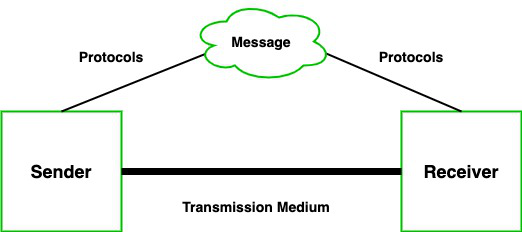A communication system is made up of the following components:
- Message: A message is a piece of information that is to be transmitted from one person to another. It could be a text file, an audio file, a video file, etc.
- Sender: It is simply a device that sends data messages. It can be a computer, mobile, telephone, laptop, video camera, or workstation, etc.
- Receiver: It is a device that receives messages. It can be a computer, telephone mobile, workstation, etc.
- Transmission Medium / Communication Channels: Communication channels are the medium that connect two or more workstations. Workstations can be connected by either wired media or wireless media.
- Set of rules (Protocol): When someone sends the data (The sender), it should be understandable to the receiver also otherwise it is meaningless. For example, A sends a message to B. If A writes in Hindi and B cannot understand Hindi, it is a meaningless conversation.

Therefore, there are some set of rules (protocols) that is followed by every computer connected to the internet and they are:
- TCP(Transmission Control Protocol): It is responsible for dividing messages into packets on the source computer and reassembling the received packet at the destination or recipient computer. It also makes sure that the packets have the information about the source of the message data, the destination of the message data, the sequence in which the message data should be re-assembled, and checks if the message has been sent correctly to the specific destination.
- IP(Internet Protocol): Do You ever wonder how does computer determine which packet belongs to which device. What happens if the message you sent to your friend is received by your father? Scary Right. Well! IP is responsible for handling the address of the destination computer so that each packet is sent to its proper destination.
0 Comments:
Post a Comment